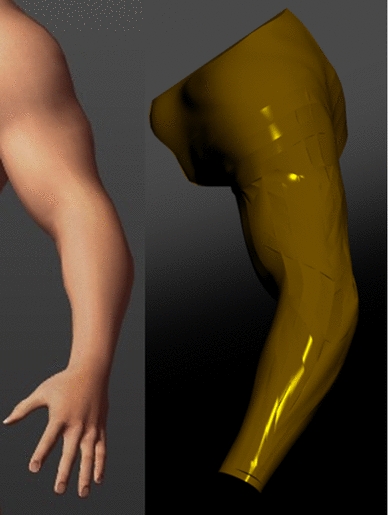Abstract
An optical device has been developed to enable a high-level quadriplegic to control two degrees-of-freedom of a manipulative-type orthosis by natural head movements. A photosensitive array on the orthosis ‘locks’ onto and follows a beam of light from a head-mounted light-emitting diode, facilitating a closed-loop mode of control as opposed to the currently used open-loop orthotic control systems. The optical and electronic detection systems which eliminate problems due to background illumination are described and the importance of some properties of the beam is discussed. Results are presented of preliminary tests with the optical controller and a conventional on/off controller coupled in turn to a simple orthosis. The speed and ease with which the orthosis position can be controlled, together with the low level of concentration required of the operator, vindicate the new closed-loop concept.
Sommaire
On a développé un système optique pour permettre à un grand quadriplégique de contrôler deux types de mouvement d'une orthose du type manipulatif par mouvement naturel de la tete. Un dispositif photosensible sur l'orthose capte et suit un faisceau de lumière provenant d'une diode émettrice montée sur la tête, facilitant un mode de contrôle en circuit fermé au lieu du circuit ouvert habituellement utilisé dans les systèmes de contrôle. La détection optique et électronique des systèmes qui éliminent les problèmes causés par les illuminations ambiantes est décrite et l'importance de certaines propriétés du faisceau est débattue. Les résultats d'essais préliminaires ainsi que le contrôleur optique et un contrôleur courant marche/arrét coup lui aussi à une orthose simple sont présentés. La rapidité et la facilité avec lesquelles la position de l'orthose peut être controleé ainsi que le peu de concentration nécessaire de la part de l'opérateur justifient le concept nouveau du circuit fermé.
Zusammenfassung
Es wurde ein optisches Gerät entwickelt, um Patienten, die an hochgradiger Tetraplegie leiden, die Kontrolle von zwei Freiheitsgraden einer Orthose in manipulativer Ausführuhg durch natürliche Kopfbewegungen zu ermöglichen. Eine fotoempfindliche Gruppe auf der Orthose verriegelt sich mit einem Lichtstrahl aus einer am Kopf befestigten lichtabgebenden Diode und verfolgt diesen, so daß eine Steuerungsmöglichkeit mit geschlossenem Regelkreis möglich ist, (im Gegensatz zu den zur Zeit verwendeten orthotischen Schaltsystemen mit offenem Regelkreis). Optische und elektronische Suchsysteme, die die durch Hintergrundbeleuchtung entstehenden Probleme ausschalten, werden beschrieben, und es wird die Bedeutung gewisser Merkmale des Lichtstrahls besprochen. Die Ergebnisse von vorläufigen Versuchen mit der optischen Steuerung und mit einem konventionellen Steuergerät für Ein/Aus-Schaltung, wiederum mit einer einfachen Orthose gekoppelt, werden ebenfalls vorgestellt, Geschwindigkeit und Leichtigkeit, mit der die Position der Orthose gesteuert werden kann, sowie die geringe Konzentration, die seitens des Patienten nötig ist, sprechen für das neue Konzept mit geschlossenem Regelkreis.
Similar content being viewed by others
References
Agzarian, J. andRead, J. H. (1973) A Multi-access interface for the disabled.Med. J. Aust. 1, 300–302.
Bahniuk, E., Reswick, J. et al. (1963) A progress report on a programmed orthotic arm.Med. Electron. Biol. Engng. 1, 509–517.
Bayer, D. M., Lord, R. H., Swanker, J. W. andMortimer, J. T. (1972) Two axis shoulder position transducer for control of orthotic/prosthetic devices.IEEE Trans. IECI-2, 61–64.
Bontrager, E. G., Nickel, V. L. andScott, I. (1972) Intra-oral telemetry control for orthotic power systems.Proc. Int. Telemetering, Los Angeles, Calif., USA.
Collins, D. W. (1967) New developments—PILOT (patient initiated light operated tele-control).Rehabilitation 63, 23–31.
Corell, R. W. andReswick, J. B. (1965) Cybernetic aspects of orthotic and prosthetic research.IEEE Int. Conf. Rec. 13, Pt. 12, 32–37.
Herberts, P., Almostion, C., Kadefors, R. andLawrence, P. D. (1973) Hand prosthesis control via myoelectric patterns.Acta. Orthop. Scand. 44, 330–409.
Kadefors, R. andTaylor, C. J. M. (1973) On the feasibility of myoelectric control of multifunctional orthoses.Scand. J. Rehab. Med. 5, 134–146.
Lipskin, R. (1970) An evaluation programme for powered wheelchair control systems.Bull. Proc. Res. Fall, 121–129.
Maling, R. G. andClarkson, D. C. (1963) Electronic controls for the tetraplegic (Possum).Paraplegia 1, 161–174.
Merchant, J. (1967) The oculometer. Honeywell report NASW-1159 for NASA Control. CFSTI:N 67 31481, 1–105.
Moe, M. L. andSchwartz, J. T. (1969) A co-ordinated, proportional motion controller for an upper-extremity orthotic device. Proceedings of the 3rd international symposium on external control of human extremities. Dubrovnik, Yugoslavia, 295–305.
Newell, A. F. andNabavi, C. D. (1969) VOTEM: the voice operated typewriter employing Morse code.J. Sci. Instrum. (J. Physics E) Series 2,2, 655–657.
Newell, P. H. andBarr, J. S. (1971) Voice operated powered devices.J. Biomechanics 4, 45–48.
Nickel, V. L., Karchak, A. andAllen, J. R. (1969) Electrically powered orthotic systems.J. Bone and Joint Surgery 51-A, 343–351.
Nirenberg, L. M., Hanly, J. andStear, E. B. (1971) New approach to prosthetic control EEG motor signal tracking with an adaptively designed phase-locked loop.IEEE Trans. BME-16, 389–398.
Radcliffe, D. F. (1974) A new optical control method for externally powered orthoses for use by high level quadriplegics. M.Eng.Sc. Thesis, Dept. of Mechanical Engineering, University of Queensland, Australia.
Roy, O. Z. (1965) A communication system for the handicapped.Med. Electron. Biol. Engng. 3, 427–429.
Soede, M. andStassen, H. G. (1973) Lightspot-operated typewriter for severely disabled patients.Med. Biol. Engng 2, 624–627.
Staros, A. andPeizer, E. (1972) VAPC Research Report.Bull. Pros. Res., Spring.
Author information
Authors and Affiliations
Rights and permissions
About this article
Cite this article
Simmons, J.M., Radcliffe, D.F. A new method for optical control of manipulative-type orthoses for high-level quadriplegics. Med. & biol. Engng. 14, 282–288 (1976). https://doi.org/10.1007/BF02478122
Received:
Accepted:
Issue Date:
DOI: https://doi.org/10.1007/BF02478122




